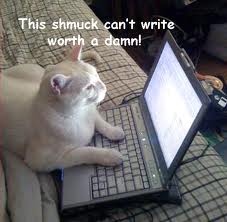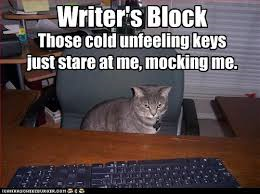
Social media and writing are a balancing act, and the Cat in the Hat knows a lot about that.
Yesterday, I was supposed to blog. That didn’t happen. Neither did writing. So what did I accomplish in two days, aside from being unaccomplished? I gained and lost some followers on Twitter and posted roughly ten tweets.
I use Twitter to build my platform, so tweeting is very important; however, if it distracts me from writing, it isn’t helping–it’s hurting. Consider my dilemma: Because of my social media platform, I’m not writing, but without a social media platform, whose going to read my writing?
I considered writing about how to avoid social media, but I think that’s unrealistic (like cutting sugar from your diet). I think moderation and self control are key. So instead, I’m going to talk about how to balance building your social media platform with writing.
Make a List
If you go to the grocery store without a list you are more likely to buy food you already have, spend more, forget to buy food you don’t have, and purchase impulse items. My sister and I are prime examples of this. I went to the store the other day and spent $50. When I go with a list, my average is $20. You see my point. Where was I going with this? Never write hungry. Just kidding.
I’m a list person. I’ve got a list of lists I need to write. Not kidding. Make a list of the things you need to accomplish that day as far as writing and social media. It might look something like this. Only picture it handwritten in chickenscratch.
1. Finish edits to last chapter (this should be on my sister’s list, but she’s probably reading “Game of Thrones”)
2. Research how long pigs live (Sorry sister, I’m picking on you again. This is for you to do as well)
3. Outline second half of book two (This one’s mine. This is where my book really starts falling apart)
4. Finish scene (I don’t go by chapters. I’m pretty happy if I finish a scene a night. I take a break after every page break)
5. Laundry (This doesn’t sound like writing checklist material until you consider the fact that you need underwear no matter where you write)
6. Follow, like, or comment to 10 blogs (I like to set a minimum of interaction to make sure I’m not just scrolling and reading. Being interactive is making your blog time not a waste of time)
7. Post three tweets (I’m aiming for 5 or more a day eventually. Like blogging, interaction will grow your platform)
8. Make lists on Twitter (see there is a list for everything. This helps keep everyone organized)
Once you’re list is done, decide which tasks are your priorities and accomplish those first. Make sure to allocate your time. Don’t schedule more to-do’s than you have time to do them. If you only have an hour, make that hour count.
Kill Two Birds with One Stone
If you have to choose between tweeting or blogging, choose to blog. You can tweet your post when you’re done, which gave you a post and a tweet. You may be thinking, supporting a blog and a Twitter account will take more time from writing. Why can’t I just have one or the other? Let me explain. The point of the social media platform is to gain followers. You’ll gain more followers if you have a blog linked to Twitter and vise versa. In the long one, this will save you time.
Schedule Social Media Time
I don’t know how many writers fall into this trap: You sit down to write, open your laptop (or notebook for you traditional writers), you open your email, Twitter, Facebook, WordPress to check your stats (it will just take a second). The next thing you know, hours have gone by, and your page is blank.
You can schedule time for social media. How you do this is up to you. You could give yourself an hour or two if you’re generous. You could even time yourself using an alarm. Whatever time-tracking method you use, make sure you stick to it.
It’s up to you whether you check your social media before or after you write. I encourage after, because after a good hard writing session, sometimes all you want to do is surf the net. It’s like a cigarette after sex. I’m just speculating, because I’ve never smoked. Besides, it might give you something awesome to Tweet about, e.g., Just wrote 1,000 words #am writing.
Don’t forget to schedule breaks.
You should schedule a little Twitter time every day. Maybe three times a day: morning, afternoon, and night. Don’t stay up too late. What about your blog? Most bloggers don’t blog every day, though it’s a good idea to check your feed at least once a day. The rule of thumb seems to be post at least three times a week. To save time, do what my sister does. Post on certain days of the week. Not only does this let your followers know when they can expect new content from you, but it also helps you set aside time to write or blog. For instance, I always post on Tuesdays because of my Tuesday Tips. This means I write on Monday so I can have it done, or at least outlined, by Tuesday.
Write Post in Advance
Twitter is easier to limit to ten minutes to an hour, because you only have 140 characters to work with. How hard can that be? When it comes to blogging, sometimes it’s hard to know how long it’s going to take. Sometimes half the time is spent trying to think of something to write. Why not pick one day out of the week and write as many posts as you can. Get the skeletal frame built, if nothing else, and save a draft so all you have to do is add the flesh and the muscle later. This will save you a lot of time. Personally, I have roughly five drafts saved.
Before you start writing drafts, make a list of topics you’d like to discuss on your blog. When you don’t take an hour wracking your brain for an idea, you’ll spend less time creating post.
I hope that was helpful. To those of you who are reading this right now, get back to writing! If you’ve already finished your writing goals for the day, feel free to smile smugly and comment below. Let me know how you balance your writing time with your social media efforts.
 One of my reading goals, aside from finishing my Goodreads list, is to get through a stack of magazines my mom gave me. I skim the pages in search of healthy meal ideas, ways to boost energy, and other ways to keep healthy. I was not expecting to get some great writing advice.
One of my reading goals, aside from finishing my Goodreads list, is to get through a stack of magazines my mom gave me. I skim the pages in search of healthy meal ideas, ways to boost energy, and other ways to keep healthy. I was not expecting to get some great writing advice.






![By Model Land Company, Everglades Drainage District (Everglades Digital Library) [Public domain], via Wikimedia Commons](https://mywriteofpassageblog.files.wordpress.com/2014/08/443px-blueprint_for_everglades_canals1921.jpg?w=221&h=300)





